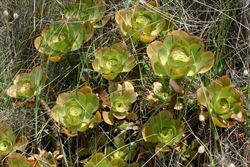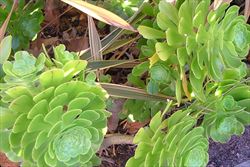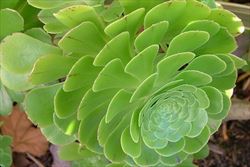Click on images to enlarge

habit (Photo: Trevor James)

habit (Photo: Sheldon Navie)

leaves (Photo: Sheldon Navie)

large flower cluster (Photo: Sheldon Navie)

close-up of flowers (Photo: Sheldon Navie)

Aeonium arboreum var. atropurpureum (Photo: Sheldon Navie)

pinwheel (Aeonium haworthii), a very similar species, is also naturalised in Australia (Photo: Trevor James)
Scientific Name
Aeonium arboreum (L.) Webb & Berthel.
Synonyms
Sempervivum arboreum L.
Family
Crassulaceae
Common Names
golden aeonium, tree aenium, tree aeonium
Origin
Native to the Canary Islands and north-western Africa (i.e. Morocco).
Naturalised Distribution
Naturalised in the coastal districts of southern Australia (i.e. in southern and western Western Australia, in south-eastern South Australia, near Melbourne in southern Victoria and in Tasmania).
Naturalised overseas in the Mediterranean region and in California, in south-western USA.
Notes
Tree aeonium (Aeonium arboreum) is a succulent plant that has escaped cultivation in southern Australia. It is regarded as a minor environmental weed in Western Australia and as a potential environmental weed in other parts of the country. This species is mainly a problem in coastal areas, particularly on sand dunes.
Tree aeonium (Aeonium arboreum) was first recorded as naturalised in South Australia in 1974, and has since been reported from conservation areas (e.g. Onkaparinga River Recreation Park) in this state. It was first recorded as naturalised in Western Australia in 1982, and has been reported growing on sand dunes, rubbish tips and road verges in south-western Western Australia, mostly between Perth and Albany. It has also become naturalised in Victoria, with the first record in 1994, and is listed in the flora of Yarra Bend Park in suburban Melbourne.
A variety of this plant with reddish-purple foliage (i.e. Aeonium arboreum var. atropurpureum) and a cultivar with blackish foliage (i.e. known as Aeonium arboreum var. atropurpureum 'Schwarzkopf' or Aeonium arboreum 'Schwarzkopf') are currently very popular in cultivation in Australia.

